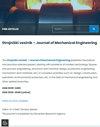Low Cost Printer for DLP Stereolithography
IF 1.2
4区 工程技术
Q3 ENGINEERING, MECHANICAL
Strojniski Vestnik-Journal of Mechanical Engineering
Pub Date : 2017-10-10
DOI:10.5545/SV-JME.2017.4591
引用次数: 20
Abstract
A general research direction of stereolithography based on digital light processing (DLP) is to reduce the production time and to increase manufacturing accuracy. Compared to fused deposition modelling (FDM) machines, machines for DLP stereolithography are expensive andthus not available to a broad range of users as it is the case with FDM 3D printers. Comparing technologies, DLP stereolithography offers quicker and more accurate production. In this paper, performances of a low cost DLP stereolithographic printer is presented. Three main challenges are treated: an uneven illumination of commercial DLP projectors, a direction of illumination and a selection of optimal 3D printing parameters. Uneven illumination of DLP projector results in smaller usable working area and poor printing quality. The problem is solved by implementing an appropriate software mask, thus the product quality is not influenced by its position on a working table. The direction of illumination has a key role in DLP stereolithography. It is shown that constrained surface (illumination through a transparent bottom of the vat) gives better 3D printing accuracy compared to free surface (illumination of the photopolymer surface) stereolithography. To further improve the product quality, the optimal process parameters are determined. Using the Taguchi based surface response methodology optimal process parameters are defined and by using them, the deviation of the actual dimensions from the specified dimensions is less than 80 μm.用于DLP立体光刻的低成本打印机
减少生产时间,提高制造精度是基于数字光处理(DLP)的立体光刻技术的一个普遍研究方向。与熔融沉积建模(FDM)机器相比,DLP立体光刻机器价格昂贵,因此不像FDM 3D打印机那样可供广泛的用户使用。比较技术,DLP立体光刻提供更快,更准确的生产。本文介绍了一种低成本DLP立体光刻机的性能。处理了三个主要挑战:商业DLP投影机的不均匀照明,照明方向和最佳3D打印参数的选择。DLP投影机照明不均匀,导致可用工作面积小,打印质量差。通过实施适当的软件掩模解决了这个问题,因此产品质量不受其在工作台上的位置的影响。光照方向在DLP立体光刻中起着关键作用。结果表明,与自由表面(光聚合物表面的照明)立体光刻相比,约束表面(通过容器透明底部的照明)具有更好的3D打印精度。为进一步提高产品质量,确定了最佳工艺参数。采用基于田口的表面响应方法确定了最优工艺参数,使实际尺寸与指定尺寸的偏差小于80 μm。
本文章由计算机程序翻译,如有差异,请以英文原文为准。
求助全文
约1分钟内获得全文
求助全文
来源期刊
CiteScore
3.00
自引率
17.60%
发文量
56
审稿时长
4.1 months
期刊介绍:
The international journal publishes original and (mini)review articles covering the concepts of materials science, mechanics, kinematics, thermodynamics, energy and environment, mechatronics and robotics, fluid mechanics, tribology, cybernetics, industrial engineering and structural analysis.
The journal follows new trends and progress proven practice in the mechanical engineering and also in the closely related sciences as are electrical, civil and process engineering, medicine, microbiology, ecology, agriculture, transport systems, aviation, and others, thus creating a unique forum for interdisciplinary or multidisciplinary dialogue.

 求助内容:
求助内容: 应助结果提醒方式:
应助结果提醒方式:


